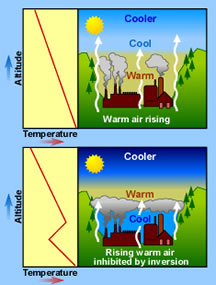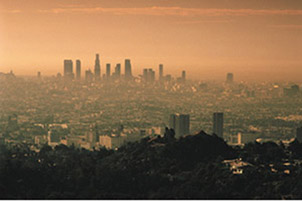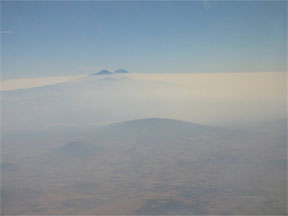Click on image for full size
Courtesy US EPA
Transport and Dispersion
Air pollution doesn't always stay where it was made. In a surprisingly short time, it can make its way around the globe. This process is called transport and dispersion and is very complex. There are many factors that influence the way pollution is spread, including wind and atmospheric stability, as well the local terrain.
Wind is caused by differences in pressure in the atmosphere. The pressure is the weight of the atmosphere at a given point. The height and temperature of a column of air determines the atmospheric weight. Since cool air weighs more than warm air, a high pressure mass of air is made of heavy cool air. A low pressure mass of air is made of warmer, lighter air. Air moves from areas of high pressure to areas of low pressure, but the Coriolis Effect will cause it to move to the right in the northern hemisphere, and to the left in the southern hemisphere. Wind speed can greatly affect the pollutant concentration. Wind can dilute pollutants and rapidly disperses them , but it can also bring pollution to otherwise clean locations.
Atmospheric stability refers to the vertical motion of the atmosphere. The air near the surface of the earth is usually warmer in the day time because of the absorption of the sun's energy. The warmer lighter air from the surface then rises and mixes with the cooler heavier air in the upper atmosphere. This unstable process is known as convection. This constant movement also results in dispersal of polluted air. Stable atmospheric conditions usually occur when warm air is above cool air. This is called a temperature inversion. During a temperature inversion, air pollution released into the atmosphere's lowest layer is trapped there and can be removed only by strong horizontal winds. Because high-pressure systems often combine temperature inversion conditions and low wind speeds, their existence over an industrial area usually results in severe smog.
The dispersion of pollution is also affected by the amount of turbulence in the atmosphere. Turbulence can be created by both the horizontal and vertical motion of the atmosphere. Other basic weather factors that affect concentration of air pollutants include solar radiation, precipitation, and humidity. Solar radiation contributes to the formation of ozone and acts to create secondary pollutants in the air. Humidity and precipitation can also act on pollutants in the air to create more dangerous secondary pollutants, such as the substances responsible for acid rain. Precipitation can also have a beneficial effect by washing soluble pollutant gases and particles from the air .
Large cities bordered by complex geographic features, such as valleys or mountains, often experience high levels of air pollution because of the natural barrier that interrupts transport and dispersion. Los Angeles, Denver, and Mexico City are examples of cities located in basins bordered by mountain ranges. These cities experience high levels of air pollution influenced by the geography of the surrounding area.















